
Fenfluramine FDA-Approved for Treatment of Lennox-Gastaut Syndrome
The decision expands the indication of Fintepla, developed by Zogenix, beyond Dravet syndrome to pediatric patients age 2 years and older with the developmental and epileptic encephalopathy.
The FDA has approved the expanded indication for fenfluramine (Fintepla; Zogenix/UCB) to include the treatment of seizures associated with Lennox-Gastaut syndrome (LGS), a rare childhood developmental and epileptic encephalopathy, in children aged 2 years and older. It marks the second indication for fenfluramine, which was approved as a treatment for Dravet syndrome (DS) in June 2020.1
The basis for the approval was data from the phase 3 Study 1601 (NCT03355209), which showed that treatment with fenfluramine at a dose of 0.7 mg/kg/day was superior to placebo in reducing monthly drop seizure frequency (MDSF).2 Zogenix included Study 1601, along with other long-term safety and efficacy data from an ongoing open-label extension (OLE) trials, in its supplemental new drug application (sNDA).
"[Lennox-Gastaut syndrome] is one of the most challenging epileptic encephalopathies to treat, and the vast majority of patients are not well controlled, despite a regimen of multiple antiepileptic drugs," said Kelly G. Knupp, MD, MSCS, FAES, associate professor of pediatrics and neurology, Children's Hospital Colorado and University of Colorado, in a statement.1 "As a complementary therapy, Fintepla offers a different mechanism of action and demonstrated ability to significantly reduce the number of seizures associated with a drop, a critical measure for managing this severe form of epilepsy."
Fenfluramine, which also received pediatric exclusivity from the FDA, will be available through a restricted distribution program called the FINTEPLA Risk Evaluation and Mitigation Strategy (REMS) Program given the drug's boxed warning for risk of valvular heart disease and pulmonary arterial hypertension.
READ MORE:
The sNDA was submitted in September 2021 and
Fenfluramine also showed statistically significant effects on secondary end points, including proportion of patients with a clinically meaningful reduction, defined as at least 50% in MDSF, which occurred in 25.3% of patients on fenfluramine compared with 10.3% on placebo (P = .0165).
Even in the 12-month, OLE of Study 1601, fenfluramine continued to show a sustained reduction in MDSF in patients with LGS who are on other antiseizure medications. Among a cohort of 247 patients who entered, results showed a 39.4% reduction in seizure frequency at month 3 (n = 227; P <.0001) and 51.8% decline for patients assessed between months 10-12 (n = 170; P <.0001) on treatment with fenfluramine. Prior to study treatment, the median baseline seizure frequency declined by 75 per month.4
Principal investigator
The medication has also shown a similar safety profile to what has been in DS. In the original Study 1601, the incidence of experiencing an adverse event (AE) was 89.7% in the 0.7 mg/kg/day group, 76.4% in the 0.2 mg/kg/day group, and 79.3% in the placebo group.2 In the OLE, the drug continued to be well-tolerated, with no observed valvular heart disease or pulmonary hypertension. Decreased appetite (n = 40; 16.2%), fatigue (n = 33; 13.4%), nasopharyngitis (n = 31; 12.6%), and seizures (n = 27; 10.9%) were the most reported treatment-emergent adverse events. There was 1 death in the study caused by aspiration pneumonia, but it was deemed unrelated to the study drug.4
At the 2021
Patients with LGS between 6 to 18 years old showed improvements in each of the 4 BRIEF 2 indexes following treatment with fenfluramine (n = 92) compared to placebo (n = 45). More specifically, for the fenfluramine group, there was a 24% improvement in Behavior (placebo, 13%; P = .118), 19% improvement in Emotions (placebo, 16%; P = .665), 27% improvement in Cognition (placebo, 13%; P = .665), and 25% improvement in Global Executive Composite (GEC) overarching summary score (placebo, 11%; P = .034).
Following the original full results of Study 1601, Knupp sat down with NeurologyLive® to break down the data. Watch below as she provided insight on the findings of the study, including the most notable end points and the importance of the data for the LGS community.
REFERENCES
1. FINTEPLA® (fenfluramine) Oral Solution Now FDA Approved for Treatment of Seizures Associated with Lennox-Gastaut Syndrome (LGS). News release. UCB. March 28, 2022. Accessed March 28, 2022. https://finance.yahoo.com/news/fintepla-fenfluramine-oral-solution-now-050000058.html
2.Knupp K, Sullivan J, Nickels K, et al. Efficacy and safety of fintepla (fenfluramine) for the treatment of seizures associated with Lennox-Gastaut syndrome: a randomized, double-blind, placebo-controlled clinical trial. Presented at AES 2020 Annual Meeting; December 4–8, 2020. Abstract 852.
3. Zogenix announces US FDA acceptance for priority review of supplemental new drug application for fintepla (fenfluramine) for the treatment of seizures associated with Lennox-Gastaut syndrome. News release. Zogenix. December 1, 2021. https://finance.yahoo.com/news/zogenix-announces-u-fda-acceptance-130000785.html
4. New Fintepla (fenfluramine) data show long-term seizure frequency reductions in patients with Lennox-Gastaut syndrome. News release. September 30, 2021. https://finance.yahoo.com/news/fintepla-fenfluramine-data-show-long-120000643.html
5. Zogenix presents new data at Virtual AAN 2021 showing improved executive function in Lennox-Gastaut syndrome (LGS) patients treated with Fintepla (fenfluramine) oral solution. News release. Xogenix. April 22, 2021. https://www.globenewswire.com/news-release/2021/04/22/2215020/0/en/Zogenix-Presents-New-Data-at-Virtual-AAN-2021-Showing-Improved-Executive-Function-in-Lennox-Gastaut-Syndrome-LGS-Patients-Treated-with-FINTEPLA-Fenfluramine-Oral-Solution.html
Newsletter
Keep your finger on the pulse of neurology—subscribe to NeurologyLive for expert interviews, new data, and breakthrough treatment updates.





































